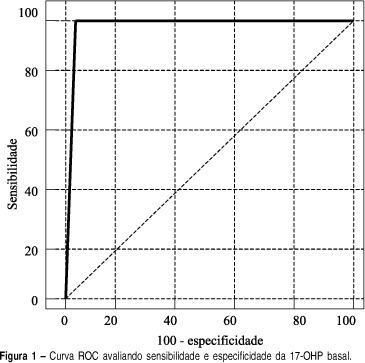Summary
Revista Brasileira de Ginecologia e Obstetrícia. 2004;26(4):295-298
DOI 10.1590/S0100-72032004000400005
INTRODUCTION: adrenal hyperplasia is a common genetic disorder and 95% of the cases are due to a 21-hydroxylase deficiency. Clinical presentation varies from life-threatening salt-losing adrenal hyperplasia to simple androgenic states, which can be of late-onset and very similar to polycystic ovary syndrome. Diagnosis is usually made by synthetic ACTH provocative tests but efforts are being made to simplify this investigation. OBJECTIVE: to evaluate basal 17-hydroxyprogesterone as a predictor of the provocative test for the diagnosis of late-onset congenial adrenal hyperplasia. METHODS: A total of 122 patients under clinical suspicion of diagnosis of late-onset congenial adrenal hyperplasia were included and retrospectively evaluated in the study. Such suspicion included signs and/or symptoms of hyperandrogenism (hirsutism, acne, oily skin, menstrual irregularity etc.). All the patients were submitted to the 0.25mg synthetic ACTH provocative test (Synacthen®). After resting for 60 minutes, the samples were taken in the basal time and 60 minutes after the administration of 0.25mg synthetic ACTH, in order to assay 17-hydroxiprogesteron, the venous access being kept through a heparinized catheter. Radioimmuoessay was the method used to accomplish the assay of seric 17-hydroxiprogesteron. The sensitivity and specificity of the basal 17-hydroxiprogesteron were measured, assessing several cutoff points. ROC curves were made to analyze the test performance, using the software Medcalc®. RESULTS: ROC curve analysis showed that the best cutoff point was 181 ng/dl, which was very similar to the most common recommendation of 200 ng/dl of the literature. The cutoff point of 200 ng/dl shows positive and negative predictive values of 75 and 100%, and accuracy of 98,4% as a diagnostic test for late-onset adrenal hyperplasia. CONCLUSIONS: considering our data, we suggest that all hyperandrogenic patients should start the investigation with basal 17-hydroxyprogesteron and in case it is above 181 ng/dl, then they should do the synthetic 17-hydroxyprogesteron provocative test.
